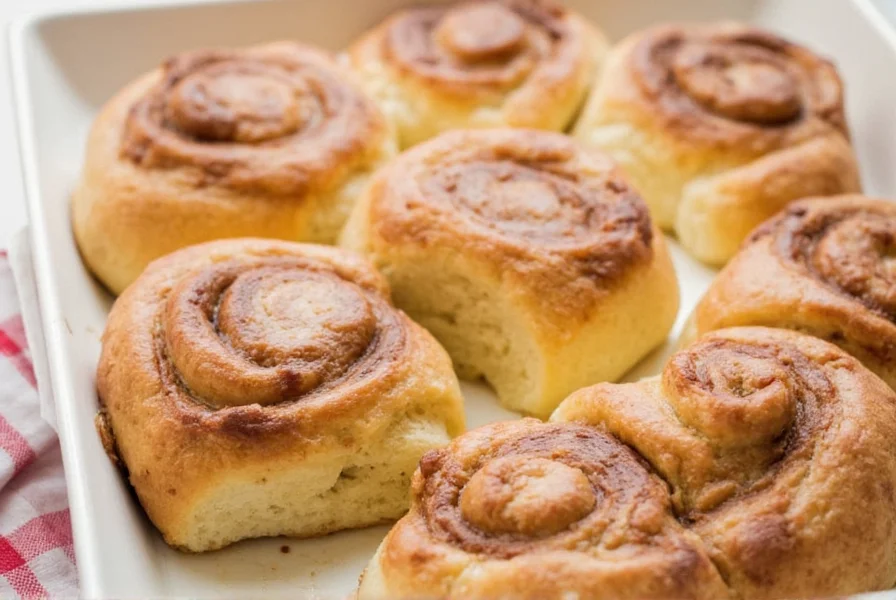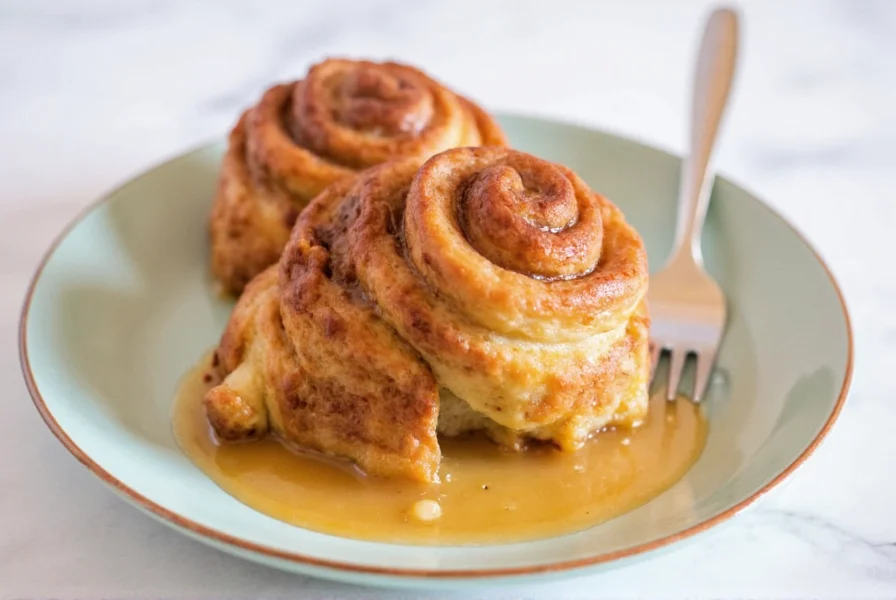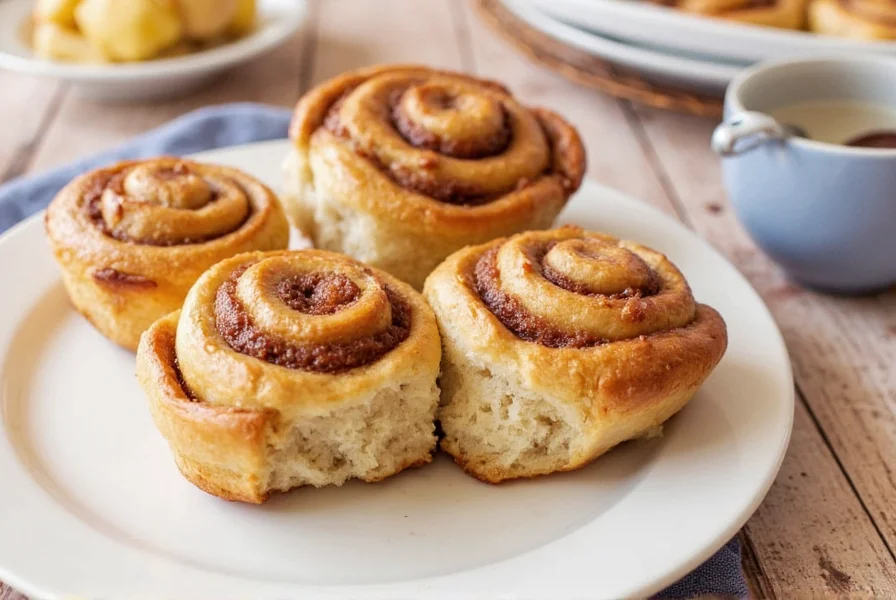Nothing beats waking up to the aroma of freshly baked cinnamon buns without the early morning prep work. Our overnight cinnamon buns recipe solves this dilemma by letting your refrigerator do the heavy lifting while you sleep. The cold fermentation process enhances both flavor and texture, creating rolls with superior complexity compared to same-day versions. Professional bakers rely on this technique to develop deeper yeast notes and achieve that coveted melt-in-your-mouth consistency.
Unlike standard cinnamon roll recipes that demand pre-dawn rising times, this method transforms weekend breakfast preparation. Simply assemble the dough in the evening, let it rest overnight, and bake when you're ready to eat. The result? Golden-brown, gooey-bottomed cinnamon buns with perfectly balanced sweetness and spice that will impress even discerning palates.
Why This Overnight Cinnamon Buns Recipe Works
The magic happens through controlled cold fermentation. When yeast dough chills overnight, enzymes break down starches into simpler sugars, creating more complex flavors while tenderizing the gluten structure. This scientific process yields several advantages over same-day preparation:
- Enhanced flavor development through slow fermentation
- Improved dough texture with better rise control
- Convenient morning baking with minimal active time
- Consistent results even for beginner bakers
- Perfect timing for holiday breakfasts or special occasions
| Equipment | Why It Matters | Substitute Option |
|---|---|---|
| 9x13 inch baking pan | Ensures proper spacing for even rising and baking | Two 8-inch round cake pans |
| Stand mixer with dough hook | Creates ideal gluten development without overworking | Hand mixing with wooden spoon |
| Instant-read thermometer | Precise milk temperature prevents killing yeast | Room temperature milk test |
| Parchment paper | Prevents sticking and simplifies cleanup | Butter/flour pan coating |
Overnight Cinnamon Buns Ingredients
Accurate measurements make the difference between bakery-quality results and disappointing rolls. Use a kitchen scale for flour when possible, as cup measurements can vary significantly by scooping method.
| Ingredient | Amount | Preparation Tip |
|---|---|---|
| All-purpose flour | 4½ cups (540g) | Spoon and level method or weigh for accuracy |
| Warm whole milk | 1 cup (240ml) | 105-110°F (40-43°C) - not hotter than wrist temperature |
| Active dry yeast | 2¼ tsp (7g) | Check expiration date for best results |
| Granulated sugar | ⅓ cup (67g) | Plus ½ cup for filling |
| Salted butter, softened | ⅓ cup (76g) | Room temperature for easy incorporation |
| Large egg | 1 | Room temperature |
| Salt | 1½ tsp | Enhances flavor and controls yeast activity |
| Ground cinnamon | 3 tbsp | Freshly ground yields best flavor |
| Brown sugar | 1 cup packed (215g) | Creates the signature gooey bottom layer |
| Heavy cream | ¼ cup (60ml) | For optional cream cheese frosting |
Step-by-Step Overnight Cinnamon Buns Instructions
Evening Preparation (20 minutes active time)
- Activate the yeast: Combine warm milk, 1 tsp sugar, and yeast in a small bowl. Let sit 5-10 minutes until foamy. If no bubbles form, start over with fresh yeast.
- Mix dough ingredients: In stand mixer bowl, combine flour, remaining sugar, and salt. Add yeast mixture, softened butter, and egg. Mix with dough hook on low speed until combined.
- Knead to proper consistency: Increase speed to medium and knead 5-7 minutes until smooth and elastic. Dough should clear the sides but stick slightly to bottom. Add flour 1 tbsp at a time if too sticky.
- First rise: Place dough in lightly greased bowl, cover with plastic wrap, and let rest at room temperature for 1 hour until doubled in size.
- Prepare filling: Mix brown sugar and cinnamon in small bowl. Set aside with softened butter for assembly.
- Roll and fill: On floured surface, roll risen dough into 16x24 inch rectangle. Spread softened butter evenly, then sprinkle cinnamon-sugar mixture. Roll tightly from long side, pinching seam to seal.
- Chill overnight: Cut into 12 equal rolls using dental floss or serrated knife. Place in parchment-lined baking dish. Cover tightly and refrigerate 8-12 hours.
Morning Baking (30 minutes)
- Warm slightly: Remove pan from refrigerator 30-60 minutes before baking to take the chill off (don't let rise completely).
- Bake to perfection: Preheat oven to 350°F (175°C). Bake 25-32 minutes until golden brown and internal temperature reaches 190°F (88°C).
- Cool and frost: Let cool 10 minutes in pan, then invert onto serving platter. Prepare cream cheese frosting while warm.
Troubleshooting Common Issues
Even experienced bakers encounter challenges with cinnamon roll recipes. Here's how to solve frequent problems with your overnight cinnamon buns:
- Dense texture: Usually caused by too much flour or expired yeast. Measure flour by weight or spoon-and-level method. Test yeast freshness before starting.
- Flat rolls: Over-rising during cold fermentation. Don't exceed 12 hours in refrigerator. Dough should be puffy but not doubled.
- Hard crust: Baking at too high temperature. Use an oven thermometer to verify accuracy. Tent with foil if browning too quickly.
- Sticky bottoms: Insufficient baking time. Rolls need 25-32 minutes at 350°F. Internal temperature should reach 190°F for proper set.
- Separating layers: Not sealing the roll seam properly. Pinch seam firmly and place seam-side down in pan.
Storage and Reheating Tips
Proper storage maintains freshness and texture. For best results:
- Store unfrosted rolls airtight at room temperature for up to 2 days
- Refrigerate frosted rolls for up to 3 days (frosting may soften texture)
- Freeze unbaked rolls for up to 3 months - thaw overnight before baking
- Revive stale rolls by microwaving 10-15 seconds with cup of water
- For restaurant-quality freshness, warm in 300°F oven for 5 minutes

Delicious Variations to Try
Once you've mastered the basic overnight cinnamon buns recipe, experiment with these popular twists:
- Nutty version: Add ½ cup chopped pecans or walnuts to the filling
- Apple cinnamon: Layer 1 cup finely diced apples between filling and dough
- Orange zest: Incorporate 1 tbsp orange zest into dough for citrus notes
- Bacon bourbon: Mix 2 tbsp bourbon and ½ cup crumbled bacon into filling
- Whole wheat option: Substitute 1 cup all-purpose flour with white whole wheat
For those with dietary restrictions, our gluten-free overnight cinnamon buns adaptation uses a 1:1 gluten-free flour blend with xanthan gum. Dairy-free versions work well with almond milk and coconut oil substitutes.

Frequently Asked Questions
Can I prepare overnight cinnamon buns further than one night ahead?
Yes, you can freeze the assembled rolls before the overnight refrigeration. Place cut rolls on a parchment-lined baking sheet, freeze solid (2-3 hours), then transfer to airtight container. When ready to bake, place frozen rolls in baking dish, cover, and refrigerate 12-16 hours before baking as directed. Add 5-8 minutes to baking time if still cold from refrigerator.
Why did my overnight cinnamon buns not rise properly in the morning?
Several factors affect rise: expired yeast, milk temperature too hot (killing yeast), insufficient resting time after refrigeration, or cold kitchen environment. Ensure yeast is fresh, milk is 105-110°F, and rolls sit at room temperature 30-60 minutes before baking. In cool kitchens, place covered pan in oven with light on for gentle warmth during this resting period.
How can I prevent the bottoms from becoming too sticky?
The sticky bottom is characteristic of good cinnamon rolls, but excessive stickiness usually means underbaking. Ensure rolls bake 25-32 minutes at 350°F until internal temperature reaches 190°F. Using dark metal pans may require reducing temperature by 25°F. Let rolls cool 10 minutes in pan before inverting to serving dish - this allows the caramelized layer to set slightly.
Can I use instant yeast instead of active dry yeast?
Yes, you can substitute instant yeast (also called rapid-rise) for active dry yeast at a 1:1 ratio. The main difference is instant yeast can be mixed directly with dry ingredients without proofing in liquid. If using instant yeast, skip the 5-10 minute activation step and mix it directly with the flour and sugar. The fermentation process and timing remain identical.
What's the best way to slice cinnamon roll dough without squishing it?
Use unflavored dental floss or a sharp serrated knife for clean cuts. For dental floss: slide under roll, cross ends over top, and pull through with even pressure. For knife method: use a gentle sawing motion with a serrated blade. Chilling the dough 15 minutes before cutting makes slicing easier. Never use a straight blade knife as it compresses the dough layers.











 浙公网安备
33010002000092号
浙公网安备
33010002000092号 浙B2-20120091-4
浙B2-20120091-4